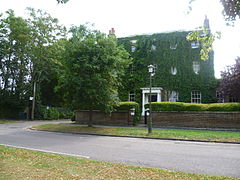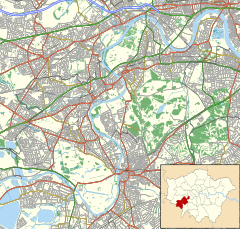
Peckforton Castle is a Victorian country house built in the style of a medieval castle. It stands in woodland at the north end of Peckforton Hills one mile (2 km) northwest of the village of Peckforton, Cheshire, England. It is recorded in the National Heritage List for England as a designated Grade I listed building. The house was built in the middle of the 19th century as a family home for John Tollemache, a wealthy Cheshire landowner, estate manager, and Member of Parliament. It was designed by Anthony Salvin in the Gothic style. During the Second World War it was used as a hostel for physically handicapped children.

Petersham is a village in the London Borough of Richmond upon Thames on the east of the bend in the River Thames south of Richmond, which it shares with neighbouring Ham. It provides the foreground of the scenic view from Richmond Hill across Petersham Meadows, with Ham House further along the river. Other nearby places include Twickenham, Isleworth, Teddington, Mortlake and Roehampton.
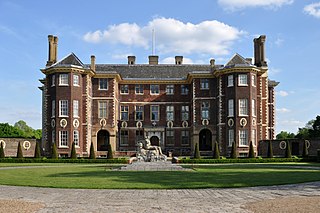
Ham House is a 17th-century house set in formal gardens on the bank of the River Thames in Ham, south of Richmond in the London Borough of Richmond upon Thames. The original house was completed by 1610 by Thomas Vavasour, an Elizabethan courtier and Knight Marshal to James I. It was then leased, and later bought, by William Murray, a close friend and supporter of Charles I. The English Civil War saw the house and much of the estate sequestrated but Murray's wife Katherine regained them on payment of a fine. During the Protectorate, his daughter Elizabeth, Countess of Dysart on her father’s death in 1655, successfully navigated the prevailing anti-Royalist sentiment and retained control of the estate.

Helmingham Hall is a moated manor house in Helmingham, Suffolk, England. It was begun by John Tollemache in 1480 and has been owned by the Tollemache family ever since. The house is built around a courtyard in typical late medieval/Tudor style. The house is listed Grade I on the National Heritage List for England, and its park and formal gardens are also Grade I listed on the Register of Historic Parks and Gardens.

The Tollemache family is an English noble family, originally from Suffolk. The family's surname is pronounced TOL-mash.

There have been two baronetcies created for people with the surname Tollemache, or Talmash, one in the Baronetage of England and one in the Baronetage of Great Britain.
Ralph William Lyonel Tollemache-Tollemache, MA, JP was an English clergyman in the Church of England. He is best known for the unusual and increasingly eccentric names that he chose for his numerous children.

William John Manners Tollemache, 9th Earl of Dysart DL in the Peerage of Scotland, was also a Baronet (cr.1793) in the Baronetage of Great Britain, Lord Lieutenant of Rutland (1881–1906), and Justice of the Peace for Leicestershire and Lincolnshire.

Ormeley Lodge is a Grade II* listed early 18th-century Georgian house, set in 6 acres (2 ha) on the edge of Ham Common, near to Richmond Park in Ham, London. It is owned by Lady Annabel Goldsmith.

St Peter's Church is the parish church of the village of Petersham in the London Borough of Richmond upon Thames. It is part of the Diocese of Southwark in the Church of England. The main body of the church building dates from the 16th century, although parts of the chancel are 13th century and evidence in Domesday Book suggests that there may have been a church on the site in Saxon times. Nikolaus Pevsner and Bridget Cherry describe it as a "church of uncommon charm... [whose] interior is well preserved in its pre-Victorian state". The church, which is Grade II* listed, includes Georgian box pews, a two-decker pulpit made in 1796, and a display of the royal arms of the House of Hanover, installed in 1810. Many notable people are buried in the churchyard, which includes some Grade II-listed tombs.

Rivington in the Borough of Chorley, Lancashire, is situated on the edge of the West Pennine Moors, at the foot of Rivington Pike overlooking reservoirs created for Liverpool Corporation Waterworks in the 19th century. There are twenty eight listed buildings within Rivington, two are classified by English Heritage as Grade II*, the rest as Grade II; Rivington has no Grade I Listed buildings.

Sudbrook Park in Petersham was developed by John Campbell, 2nd Duke of Argyll in the early 18th century. Sudbrook House, designed for Argyll by James Gibbs and now Grade I listed by Historic England, is considered a fine example of Palladian architecture. The house and is surrounding park have been the home of the Richmond Golf Club since 1891.

Ham Common is an area of common land in Ham, London. It is a conservation area in, and managed by, the London Borough of Richmond upon Thames. It comprises 48.69 hectares, the second largest area of common land in the borough, 2 acres (0.81 ha) smaller than Barnes Common. It is divided into two distinct habitats, grassland and woodland, separated by the A307, Upper Ham Road. It is an area of ecological, historical and recreational interest, designated a Local Nature Reserve.

Montrose House is a late 17th-century Grade II* listed building at 186 Petersham Road, Petersham in the London Borough of Richmond upon Thames.
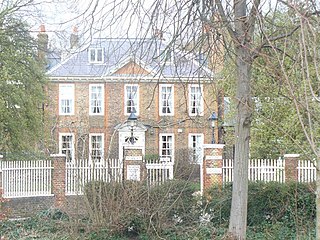
Douglas House is a Grade II* listed early 18th-century Queen Anne-style house in Petersham in the London Borough of Richmond upon Thames. It is now the site of the German School London.

Sir Lyonel Felix Carteret Eugene Tollemache, 4th Baronet was an English landowner.
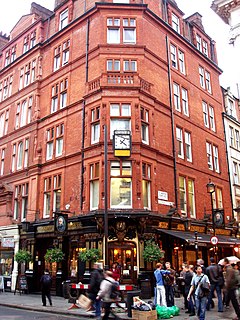
The Salisbury is a Grade II listed public house at 91–93 St Martin's Lane, Covent Garden, London which is noted for its particularly fine late Victorian interior with art nouveau elements.

Langham House Close on Ham Common in Ham in the London Borough of Richmond upon Thames is a development of three Grade II* listed buildings designed in 1955 by the British architects James Gowan and James Stirling. The Le Corbusier-influenced buildings were the architects' first major project working together and cemented their reputation as leaders amongst the Brutalist movement. The development was constructed during 1957–58 for Manousso Group.

Heath Hall, Heath, Wakefield, West Yorkshire is a country house dating from 1709. Originally called Eshald House, the estate was purchased by John Smyth whose nephew engaged John Carr of York to reconstruct the house between 1754 and 1780. In the 19th century, the house was remodelled by Anthony Salvin. Heath House is a Grade I listed building.
